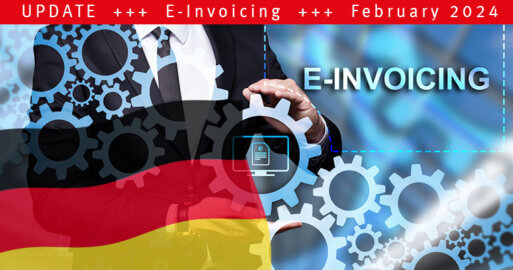EDI vs. E-invoicing: Insights into Digital Communication

In the business world, digital processes such as electronic data interchange (EDI) and e-invoicing have revolutionized everyday work. Many of us now take these technologies for granted. However, they have a far-reaching and fascinating history. This article looks at the evolution of EDI and e-invoicing and looks at exactly why they are so important to modern business. We also draw comparisons between the two and show you how SEEBURGER can help you integrate EDI and e-invoicing into your IT landscape. However, before we take a closer look at the differences and similarities between EDI and e-invoicing, let’s first take a look back and explore their roots.
The beginnings of EDI
The history of electronic data interchange (EDI) dates back to the 1960s. At that time, most business processes were paper-based and correspondingly inefficient and resource-heavy. The need to automate and speed up these processes led to the birth of EDI. EDI transmits a variety of business documents electronically in a structured way. These include:
- Invoices (just like in e-invoicing today)
- Purchase orders (PO)
- Purchase order responses (PORs)
- Purchase order acknowledgements (POAs)
- Advanced shipping notices (ASNs)
- and much more.
The transport and logistics sectors were the first industries to recognize the value in EDI. Imagine the massive paperwork that was required to coordinate the international shipping, receiving and tracking of goods. Once EDI entered the scene, transport companies were able to exchange data quickly and error-free, saving both time and money.
Thanks to the introduction of standards such as ANSI X12 and EDIFACT, EDI became increasingly popular in the 1970s and 1980s. These standards enabled companies of various sizes and in different industries to exchange business documents with one another electronically.
The emergence of e-invoicing
As the name says, e-invoicing is all about invoicing. It is a way to electronically create and send invoices. While EDI started back in the 1960s, e-invoicing came on to the scene a little later. Following the advent of an accessible internet in the 1990s, e-invoicing became more and more attractive with the growing need for businesses to operate more efficiently and cost-effectively.
E-invoicing not only saved firms money by eliminating the need for paper, it also significantly accelerated the invoicing process as a whole. Businesses were able to send out their invoices faster, which led to faster payment.
The driving forces behind EDI and e-invoicing
A major factor that has contributed to the growth of EDI and e-invoicing is globalization. Once companies started operating worldwide, they had a burning need to make their communication systems as efficient as possible.
Another important driver has been regulatory change. Many governments have made e-invoicing mandatory or at least incentivized its adoption to reduce fraud and increase transparency. As a result, there are now several countries digitalizing their invoicing processes, with others already enjoying the benefits of e-invoicing.
Technical progress and its effect on EDI and e-invoicing
With the advent of the internet, the world of business communication experienced a paradigm shift. Until then, companies had needed to use expensive proprietary networks (called Value Added Networks or VANs) to conduct EDI transactions. The internet provided a cheaper, more accessible platform that ultimately accelerated the adoption of EDI and e-invoicing.
In the 2000s, more and more companies started to move from traditional EDI formats to XML-based formats. This was partly due to a desire for more flexibility and interoperability. XML offered a more universal, customizable way to structure and share data, which also made it easier to integrate separate systems.
E-invoicing and cloud computing – a match made in heaven
Just as the advent of the internet gave EDI a boost, e-invoicing has been greatly pushed by cloud computing. Once companies could securely store and access data in the cloud, they were able to further optimize their invoicing processes while also benefitting from greater security. Cloud-based e-invoicing platforms let organizations send, receive and process invoices in real time, wherever the other party was located.
EDI versus e-invoicing: a closer look at the similarities and the differences
Although EDI and e-invoicing have different origins and development paths, their basic principles are similar. Both aim to streamline business processes by automating data interchange. However, while EDI covers a wide range of business documents, from purchase orders to shipping notifications, e-invoicing focuses exclusively on invoices.
Another difference lies in the complexity of setting up the systems. While adopting e-invoicing is not particularly complex as it tends to use web portals or standardized cloud platforms, EDI may require extensive, deep integration and specialist software depending on a company’s specific requirements.

Compliance in EDI and e-invoicing
In recent years, new regulatory requirements have regularly sprung up for both EDI and e-invoicing. It is e-invoicing that is most often the focus of regulatory efforts as governments seek to increase transparency and prevent tax fraud. Companies need to constantly adapt and update their systems to continue to comply with these laws, which creates both challenges and opportunities for providers in this space.
Below is a comparison of compliance issues for each technology.

From a compliance perspective, e-invoicing often has more stricter and comprehensive regulations to adhere to as these often cover taxation issues and have a legal basis. As EDI is a system with a broader application, regulations tend to vary by specific instance. However, it is important that you know and comply with the EDI regulations for your region and industry.
The growing importance of real time transactions for EDI and e-invoicing
While days or weeks used to pass before a business transaction was completed, in today’s digital age we expect things to happen in real time. This push for real-time transactions has impacted both EDI and e-invoicing. Businesses are now looking for solutions that enable instant order confirmations, shipment notifications and payment receipts. This immediacy allows companies to be more agile and responsive, ultimately resulting in an improved customer experience.
How to get more out of EDI and e-invoicing
A further trend is integrating EDI and e-invoicing with other digital tools and platforms. These may include Customer Relationship Management (CRM) systems, Supply Chain Management Software or accounting or bookkeeping platforms. The end-to-end integration with these tools ensures a more efficient, more precise data transfer that minimizes errors and streamlines your business processes.
How can SEEBURGER support you with your EDI and e-invoicing needs?
In this ever-evolving landscape, SEEBURGER has established itself as a trusted partner for businesses worldwide. But how exactly does SEEBURGER support companies with their EDI and e-invoicing needs?
- Flexible solutions
SEEBURGER delivers customized solutions tailored to the specific requirements and challenges of your company. - Compliance and security
Drawing on a thorough understanding of international standards and legal requirements, SEEBURGER ensures that companies are always on the safe side. - Integration made simple
The SEEBURGER BIS platform is designed to slot in seamlessly with existing systems and tools, simplifying set up. - Training and support
As well as first class technical solutions, SEEBURGER offers comprehensive training and support to ensure that customers get the best out of their investment.
EDI and e-invoicing – the final word
EDI and e-invoicing have a long and impressive history behind them and will undoubtedly continue to play central roles in the business world. With ever-increasing expectations for speed, efficiency and reliability, businesses need dependable partners and a reliable platform now more than ever.
SEEBURGER is poised and prepared to accompany companies on their way to a digital future in which data flows smoothly through streamlined business processes. By using today’s technologies – and preparing for tomorrow’s – companies can ensure that they remain competitive and continue to deliver great value to their customers.
Good to Know
What is EDI?
Learn everything you need to know about EDI. What does EDI mean and how does it work? What software do you need for EDI and how do you choose the right EDI set-up? Discover what a typical EDI project looks like and how you can implement an EDI solution in your company. Finally, our FAQs at the end answer the most frequently asked questions about EDI.
Read nowThank you for your message
We appreciate your interest in SEEBURGER
Get in contact with us:
Please enter details about your project in the message section so we can direct your inquiry to the right consultant.
Written by: Rolf Holicki
Rolf Holicki, Director BU E-Invoicing, SAP&Web Process, is responsible for the SAP/WEB applications and digitization expert. He has more than 25 years of experience in e-invoicing, SAP, Workflow and business process automation. Rolf Holicki has been with SEEBURGER since 2005.





